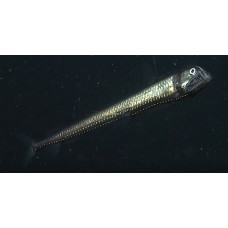Latin name
Chauliodus sloani
Other name
Chauliodus sloani
Identification
C. sloani has a low lipid content (~2.4%). The body is covered with a thick, transparent, gelatinous shell. Like many Stomiidae, its scales and caudal skeleton are weakly ossified, and it lacks a gas-filled swim bladder. Photophores on the ventral and lateral sides of Sloane's viperfish allow them to exhibit bioluminescence. During the study, it was observed that they emit light for about 5-10 seconds when their tail is compressed.
Teeth
The main feature of C. sloani is its huge teeth. When the jaws are closed, the teeth fit tightly together to form a cage in which prey can likely be trapped. Its jaw can be tilted back, allowing it to open its jaws 90° to catch prey as large as 63% of its own body. However, its teeth are fixed in place, firmly attached to the jawbone. The immobility of its huge teeth forces it to open its jaws so wide. The size, shape, location, and number of teeth are the same in all members of C. sloani, and each canine is highly specialized. C. sloani probably lures prey into its mouth with a photophore or by bending its long dorsal ray so that it hangs out of its mouth. The anterior premaxillary tooth, which is relatively straight and has sharp projections, can then be used to wound larger prey. The curved second premaxillary tooth is thought to be used as a dagger to hold larger prey.
Features of fish fins
C. sloani has a bifurcated caudal fin, an adipose fin, and a dorsal fin located just behind the head. Almost all of its fins contain soft rays. Dorsal spines (total): 0; Dorsal soft rays (total): 5-8; Anal spines: 0; Anal soft rays: 10-13.
Fish colouring
The body of this fish is silvery iridescent.
Distribution
It lives in tropical and temperate waters. It is widely distributed in the Atlantic and western Mediterranean, as well as the Indian and Pacific Oceans. In the Atlantic, its latitudinal range extends from 35°N to 55°N, with the highest abundance around 45°N. In the Arabian Sea, its range extends mainly south of 10°N latitude.
Habitat
Bathypelagic marine species. Depth range 200-4700 m, typically 494-1000 m.
Size
Maximum length 35 cm.
Behavior
Occupies deep oceanic waters, may move to near-surface waters at night.
It is thought that Sloane's viperfish can adjust the intensity of the bioluminescence of its abdominal photophores to camouflage itself from predators that may see its shadow from below.
Food and feeding habits
The C. sloani is a major consumer of lanternfish, other bony fish and crustaceans. They also feed on eggs and algae. C. sloani typically feeds on large prey, in some cases consuming up to 50% of their own body weight, and the size of their prey allows them to feed infrequently and occasionally, maximizing energy efficiency. This fish is considered a specialized predator because of the small list of prey found when stomach contents are analyzed. Time of day has no effect on their feeding habits.
Reproduction
Oviparous. Females of C. sloani reach maturity at 133 to 191 mm, while males mature at a slightly shorter length.
Fishing
Not of interest for fishing.
Relationship with a person
Harmless.
| Classification | |
| Phylum | Chordata |
| Class | Actinopterygii |
| Squad | Stomiiformes |
| Family | Stomiidae |
| Genus | Chauliodus |
| Species | C. sloani |
| Features | |
| Conservation status | Least Concern |
| Habitat | Pelagic |
| Life span, years | No information |
| Maximum body weight, kg | No information |
| Maximum length, cm | 35 |
| Sailing speed, m/s | No information |
| Threat to people | Not edible |
| Way of eating | Predator |
Sloane's viperfish
Tags: sloanes viperfish

